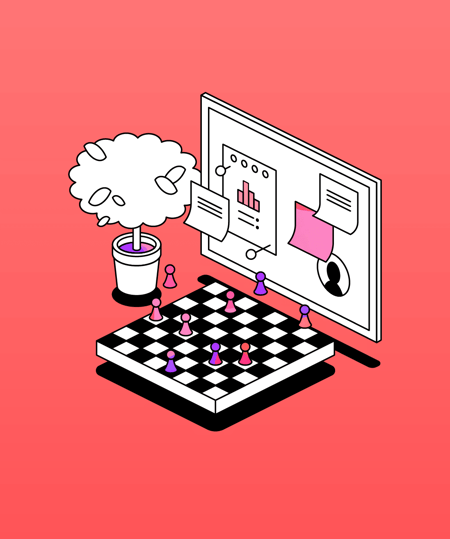Bring an icon to life with CSS
Joss shares how you can create your own icon with CSS
 2 min read
2 min read
 Published: 18 Apr 2023
Published: 18 Apr 2023
 Joss Dixon
Joss Dixon
It’s arguable that good animation should complement the page and add a certain finesse to the overall design rather than being a focal point of it. If anything, err on the side of caution and consider the possibility of a particular flourish becoming a bit irritating when seen repeatedly by the user. If that seems at all likely, tone it down and go for something less dramatic.
I had a perfect opportunity to put this into practice recently while working on a prototype for a new feature at Glean. While I won’t reveal the specifics of the work for fear of sharing highly classified information, it’s still easy enough to illustrate the point.
Let’s say you have a small icon or image that you want to animate, but rather than giving it a simple rotation or fade you want to show the effect of it going through a small change in state. Fundamentally, animating this change relies on keeping the icon whole while changing one element of it. For a good example, I recommend hovering your mouse over the small mascot face in the top left corner of the Twitch website.
As a disclaimer, there may well be much better ways of doing this (and indeed you can probably see that the following is not what Twitch do), but for me this was a quick and straightforward solution. The trick is to give the illusion of there being a single image which changes, when in fact it’s simply a transition between two similar images.
![]()
I’ll show you the way that I achieved this. First, you’re going to have a structure like this:
<div class=“image-container”>
<img class=“image-one”>
<img class=“image-two”>
</div>
Secondly, use a grid to position the images on top of each other. For me, this is preferable to using absolute and relative positioning because it’s much simpler and more responsive. This would mean that in your CSS you’d have something like this:
.image-container {
display: grid;
}
.image-one {
grid-row: 1;
grid-column: 1;
}
.image-two {
grid-row: 1;
grid-column: 1;
}
…
const [hovered, setHovered] = useState(false)
…
<div class=“image-container”>
<img
class={ hovered ? “image-one–hovered” : “image-one”}
onMouseEnter={() => setHovered(true)}
onMouseLeave={() => setHovered(false)}
>
<img
class={ hovered ? “image-two--hovered” : “image-two”}
onMouseEnter={() => setHovered(true)}
onMouseLeave={() => setHovered(false)}
>
</div>
…
.image-one {
grid-column: 1;
grid-row: 1;
&--hovered {
grid-column: 1;
grid-row: 1;
animation: tilt 1s ease-in-out;
}
}
.image-two {
grid-column: 1;
grid-row: 1;
opacity: 0;
&--hovered {
grid-column: 1;
grid-row: 1;
animation: fade 1s ease-in-out;
opacity: 0;
}
}
@keyframes tilt {
0% {
transform: rotate(0deg);
opacity: 1;
}
50% {
transform: rotate(-15deg);
opacity: 0;
}
60% {
transform: rotate(-15deg);
opacity: 0;
}
100% {
transform: rotate(0deg);
opacity: 1;
}
}
@keyframes fade {
0% {
opacity: 0;
}
50% {
opacity: 1;
}
60% {
opacity: 1;
}
100% {
opacity: 0;
}
}
As mentioned before, there are limitations to this method and I wouldn’t say it’s objectively the best. Using useState can leave you vulnerable to bugs such as small visual discrepancies arising from rendering two different images. Also, you’re somewhat restricted in the degree to which you can animate, and this would probably be difficult to fine tune. However, I’d recommend it as a quick solution that gives you lucid code and doesn’t rely on manipulating SVGs.
More from Tech Blog
View All
 2 min read
2 min read
The engineer housewife: An unconventional role for tech companies
Here we discuss the concept of an 'Engineer Housewife' - a role focused on maintaining and organizing the engineering environment to boost efficiency and collaboration, ultimately allowing engineers to focus on innovation.

 4 min read
4 min read
Glean Engineering away day: a winning formula for success
Our Head of Engineering, Mala Benn, sheds light on the recent Glean Engineering away day and shares her 10 top tips that made the day a roaring success.

 3 min read
3 min read
Glean hack week - developing a Minimal Loveable Feature
Our Glean Engineering team recently took time out of their busy schedules to run a hack week, designed to build innovative solutions and unleash their creativity. Engineering Manager, Mala Benn, is here to tell us how they got on.





